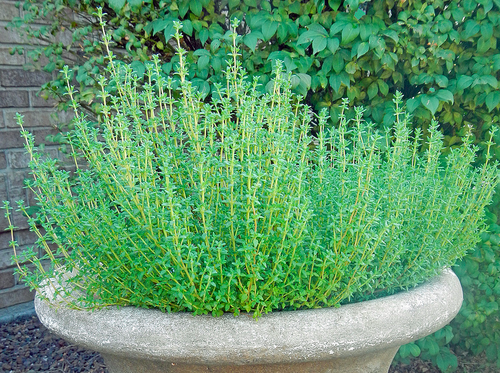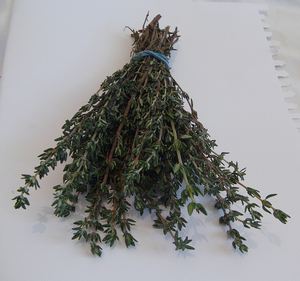
Thyme (Thymus vulgaris, common thyme) is a hardy perennial herb with a strong, pleasant aroma. The stems are usually woody at the base and there are many small leaves. It is a sub-shrub that grows to a low level, approximately 20cm or 8 inches in height (its spread is similar). The leaf colour varies, from green to grey-green, yellow and variegated.
Romans and Greeks used thyme as a culinary herb, prized for its aroma and flavour.
Growing thyme
- Choose seed or cuttings. Whether your not you choose seed or cuttings depends on the thyme variety, as some do better one way over the other.
- If growing from cuttings, take these during summer.
- Choose a spot with gravelly, stony soil. Thyme prefers poor soil that drains well. Thyme will grow poorly in wet soil. Thyme likes full sunshine but will tolerate a slightly shady spot provided it gets some sunshine during the day.
- If preferred, grow in a container indoors or on the porch.
- Space more than one thyme plant approximately 30cm/12 inches apart.
Thyme needs to be kept warm through winter months and needs protection in harsh winter environments.
Harvesting thyme
- For cooking straight away: Cut thyme at the tips in the mornings and use immediately for best flavour.
- For drying: Cut the whole plant down to around 5cm/2 inches to the ground. Cut before it blooms.
Drying thyme

Thyme can be dried and kept for many months for use in cooking. Hang in bunches with a paper bag tied around it (to catch the leaves) or lay on trays/baking sheets. Leave to air dry.
If you use a microwave, thyme can be dried in the microwave as well.
If you want to freeze thyme, this can be done. Cut into small sprigs and freeze in bags.
Using thyme as a culinary herb
Thyme can be used either fresh or dried. There are numerous ways to use thyme in cooking, such as:
- Add to stuffing mixes.
- Use as part of bouquet garni.
- Add to soups, casseroles and meat dishes.
- Steep in vinegar and oils for thyme infused flavouring.
- Add to roasted vegetables.
Thyme has a strong flavour, so use sparingly.
Medicinal use of thyme
Thyme has various medicinal uses. It is used for such things as:
- An antiseptic, antibiotic and antifungal.
- A deodorant.
- Anti-dandruff and conditioner for hair.
- Acne control.
- Coughs and colds (internal). It makes a good gargle for tonsillitis oral thrush.
- Mucous clearing.
- A salve for cuts and bruises.
Thyme should not be taken medicinally during pregnancy.
Other uses of thyme
Some other uses of thyme include:
- Bees love thyme; use it to attract them to the garden.
- Use between pavers to release a lovely aroma when trodden on.